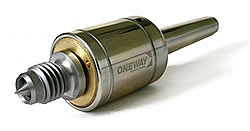FAQ : Live Center 'Play'
Q. Should I be concerned if my Live Center bearings have some 'play'?

A. At Oneway, we strive to make our products both practical and functional, while keeping in mind they must be a pleasure to use, and if possible, be cost competitive.
Using this philosophy we design and manufacture a premium quality Live Center that is specifically aimed at the woodturning fraternity.
The design requirements are as follows:
- It must be reasonable cost.
- It must not rust when left in a damp environment.
- It must be slim to allow the toolrest to clear when turning small parts.
- It must be capable of running at high speed.
- It must be versatile enough to perform most needed functions.
- It must be rigid enough to perform the job it is supposed to do.
- We must have customer satisfaction.
We have adequately achieved all of the above design parameters except, we do occasionally get complaints about some 'play' or 'slop' in the bearings we use. The questions we then have to ask are:
- How much 'play' do we have?
- Does it affect performance?
- Is 'play' preventable?
- Why does the competition not have 'play'?
How much 'play' do our Live Centers have?
We have measured the radial and end 'play' of over 100 Live Centers including ones returned due to 'excess play'. When measured with .0001 indicators, they never exceeded .0005 radial play and end play never exceeded .004.
These are acceptable limits for C3 clearance bearings when properly mounted (and yes, this clearance, especially end play can be felt with sensitive fingers).
Does it affect performance?
The clearance does not affect performance for two reasons:
We mount two (2) bearings in tandem to prevent cantilevering and to increase load capacity. One bearing will carry 100% of the end thrust load and 50% of the radial load. The other bearing will carry the 50% balance of the radial load. The moment tailstock pressure is applied, the inner bearing race is displaced by the amount of end play (approx .004) and the radial play disappears at the same time. This occurs through ball displacement inside the track in which they run. To understand why this is, you must know that the ball radius is smaller than the race radius, thus assuring point contact which through end pressure eliminates play.
Point contact assures that ball bearings are possible. Full contact ball to radius would cause rapid overheating and bearing failure.
Is 'play' preventable?
'Play' is preventable by putting in more expensive precision bearings (i.e. bearings with no detectable end or radial play). These bearings would cost from 5 to 10 times more than a standard C3. They would require oil lubrication and would in service perform no better than low cost but good quality bearings.
A different set of bearings such as tapered roller bearings could be used. However, to prevent play they would need to be finely adjusted, need regular lubrication, be larger in diameter, and tend to run hot at high speeds. For these reasons they would be expensive and unsuitable.
Bearings can be measured for end play and then shimmed with different sized spacers to eliminate play. However the incurred labour cost does not improve the performance sufficiently to justify the expense.
Why does the competition not have 'play'?
The simple answer to this question is found in the way Oneway makes their Live Centers.
Oneway Live Centers are made from premium steel. They are first turned, drilled and then heat treated. The body and tang are then precision ground between centers. They are then nickel plated, after which the bearing bore is precision ground with zero pressure on the body which assures perfect roundness. Perfect roundness allows the bearings to retain their perfect roundness when installed. Thus the .0005 play remains allowing long life and true running with tailstock pressure.
The competition typically turns the tang and body (skipping the grinding step) and is not heat treated. This makes the out of roundness typically range from .0005 to .0015, with press fits in the .001 to .002 area. When the bearings are pressed into this housing, the bearing is forced out of round and 'presto' there is no discernable play. This can lead to overheating, and ultimately a short life.
Why do some Oneway Live Centers have more 'play' than others?
This is caused by bearing manufacturer tolerances, and their track placement in the races.
Typically a track on the size of bearing that we use can be .003 off center. So if two equal spacers are installed, end play can be as little as 0 or as much as .004 (total play) in one bearing.
We hope this removes any concerns you may have about the 'play' in our Live Centers, and reassures you that our Live Centers are of an excellent quality.
--------------------------------------------------------------------------------
To find out more about our Live Centers (including pricing), click
here.
Need a Question Answered?
If you have a question or problem that you need answering regarding a Oneway product, email it to Kevin (Technical Support) at kevinclay@oneway.ca
Quick Reference
- Should I be concerned?
- How much play?
- Is performance affected?
- Is it preventable?
- Competition
- More 'play' than others. Why?